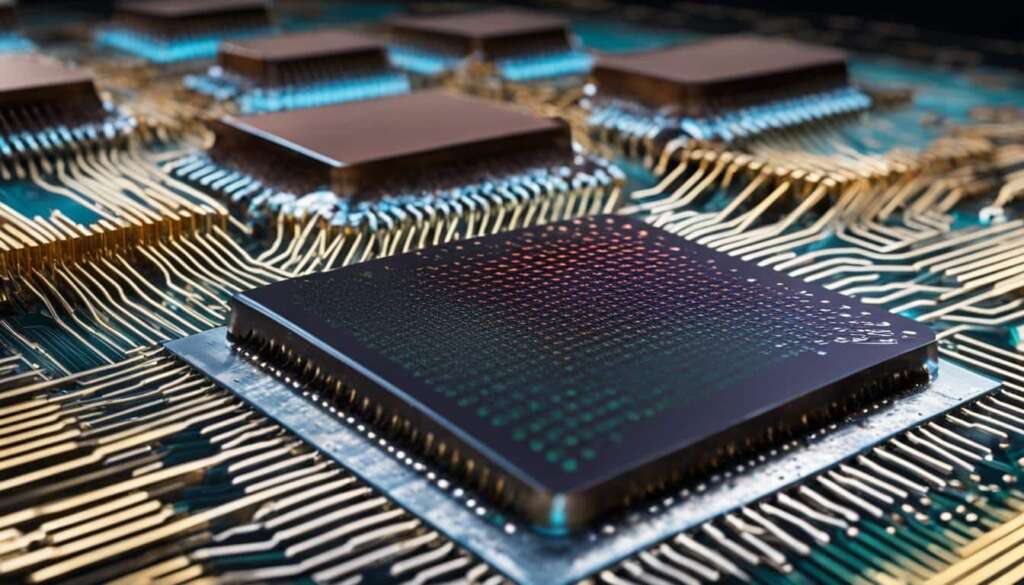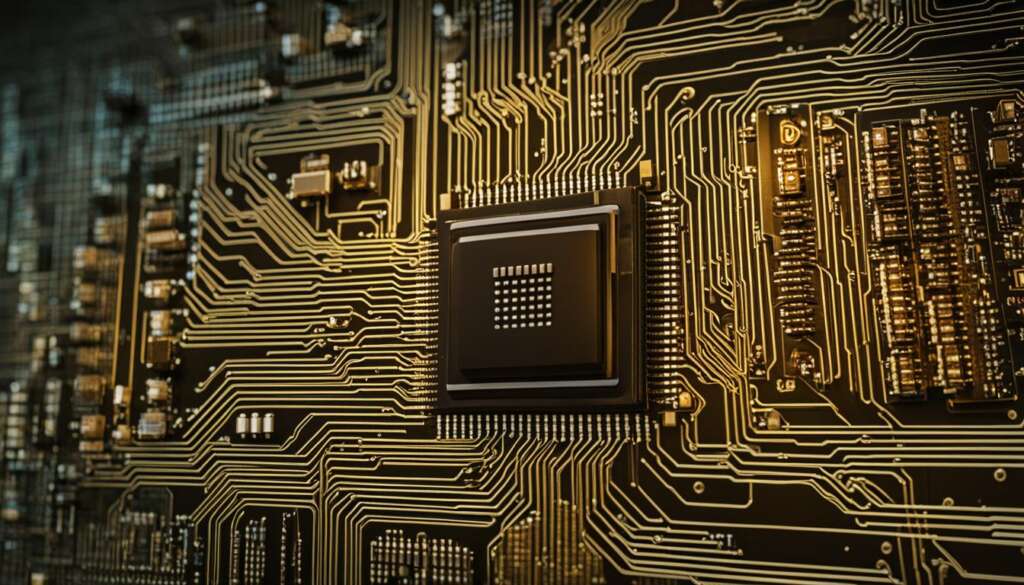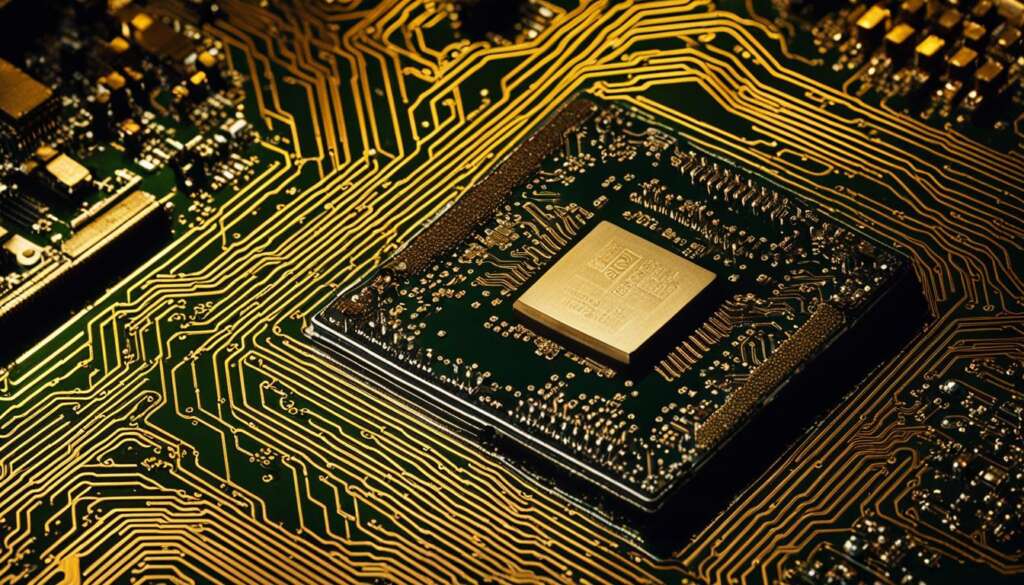Table of Contents
Moore’s Law, named after Intel engineer Gordon Moore, has had a significant impact on the evolution of processors. It states that the number of transistors on a chip doubles approximately every two years, leading to increased computing capacity and lower costs. This has resulted in rapid technology advancements, fostering microprocessor innovation and driving the development of the semiconductor industry.
However, in recent years, the exponential growth predicted by Moore’s Law has slowed down, with processor speeds stagnating between 2 and 4 GHz. The challenge of fabricating smaller transistors has reached a limit, making it harder to manufacture. Nevertheless, Moore’s Law has guided chip makers in the development of faster CPUs, enabling advancements in technology.
The Challenges of Shrinking Transistors
As the evolution of processors continues, the fabrication of smaller transistors presents a significant challenge for chip manufacturers. The current method of fabricating these transistors, known as the photolithographic process, utilizes a 193 nm wavelength light to create chips with transistors as small as 14 nm. In fact, Intel has even implemented a 10 nm process on its 8th generation processors. However, as we approach the theoretical limits of transistor size, which is expected to be below 2 nm after 2021, new challenges arise.
The density of transistors on microchips creates higher temperatures, which poses a limitation on performance. Cooling down the transistors becomes increasingly difficult as they become smaller, making it harder to dissipate the heat generated. This limitation in temperature management affects the overall performance of the processors and the efficiency of the computing systems. Therefore, new techniques and architecture designs are required to overcome these challenges in microprocessor development.
Researchers and engineers are exploring alternative methods and materials to address the limitations of chip manufacturing. This includes investigating new chip fabrication processes, such as extreme ultraviolet lithography, which utilizes a shorter wavelength light to create even smaller transistors. Additionally, novel materials like graphene are being studied as potential alternatives to silicon-based CPUs. Graphene offers higher speeds and lower energy consumption, making it an attractive option for future chip designs. However, the cost-effectiveness and scalability of producing graphene-based chips still need to be addressed.
| Challenges of Shrinking Transistors | Solutions |
|---|---|
| Higher temperatures due to increased density | Investigating new cooling techniques and materials |
| Limitations in cooling down smaller transistors | Exploring advanced thermal management solutions |
| Need for new techniques and architecture designs | Developing innovative chip fabrication processes |
| Cost-effectiveness and scalability of graphene-based chips | Continued research and development in materials science |
The End of Moore’s Law
Moore’s Law, the guiding principle behind the growth of processors, is approaching its theoretical limits. As the number of transistors on chips continues to increase, so does the heat generated and the performance limitations. The physical constraints of cooling down the transistors are becoming more challenging, making it increasingly difficult to create smaller circuits. The exponential growth predicted by Moore’s Law is no longer sustainable, necessitating the exploration of new techniques and architecture designs to continue advancing in microprocessor development.
One solution that has emerged is the hybrid core design, inspired by the ARM architecture used in smartphones and tablets. This design incorporates both performance-cores and efficient-cores into the CPUs of companies like Intel and AMD. By combining high-performance cores for demanding tasks with energy-efficient cores for lighter workloads, these processors are able to overcome the limitations imposed by Moore’s Law, delivering improved performance and efficiency.
Table: Comparison of Moore’s Law and Hybrid Core Design
| Aspects | Moore’s Law | Hybrid Core Design |
|---|---|---|
| Transistor Count | Exponential growth every two years | Optimized combination of performance and efficiency cores |
| Performance | Stagnating due to heat and power limitations | Improved performance through a mix of high-performance and energy-efficient cores |
| Efficiency | Lower efficiency at higher transistor counts | Enhanced efficiency with a blend of performance and efficiency cores |
| Future Potential | Reaching physical limits | Continued advancements beyond Moore’s Law |
The hybrid core design represents a significant shift in microprocessor development, allowing for continued improvements in performance and energy efficiency even as Moore’s Law nears its end. By combining different types of cores, chip manufacturers are able to break through the ceiling imposed by the physical limitations of transistor counts and thermal constraints. As the future of computing unfolds, the hybrid core design and other innovative approaches will play a vital role in driving the next era of technological advancements.
Note: The image above visually represents the theoretical limits of Moore’s Law and the need for new techniques and architecture design to overcome performance limitations.
Alder Lake micro-architecture: Paving the Way for Energy-efficient and Greener Technology
The Alder Lake micro-architecture, developed by Intel, marks a significant milestone in the pursuit of energy efficiency and greener technology. Built on a 10 nm fabrication process, this innovative micro-architecture offers Intel’s best performance per watt, making it a game-changer in the semiconductor industry.
While energy-efficient processors were initially designed for mobile devices, bringing this efficiency to desktop computing has its own set of benefits. CPUs that require less energy and generate less heat not only save on electricity costs but also contribute to a more sustainable and eco-friendly approach to technology.
“The advancements in performance and efficiency brought by the Alder Lake micro-architecture mark a significant milestone for Intel and the industry as a whole.”
The Alder Lake micro-architecture combines high-performance cores with efficient cores, allowing for the optimization of power consumption based on workload demands. This dynamic approach to processing enhances overall system performance while maintaining energy efficiency.
As the industry continues to prioritize energy efficiency and environmental sustainability, the Alder Lake micro-architecture sets a new standard for future processor designs. Its impact goes beyond performance and power efficiency, as it paves the way for more environmentally friendly technology solutions that align with the growing demand for greener computing.
Graphene and Quantum Computing
One of the most promising advancements in the field of microprocessor development is the exploration of graphene-based chips as an alternative to traditional silicon-based CPUs. Graphene, a single layer of carbon atoms arranged in a hexagonal lattice, offers several advantages over silicon, including higher speeds and reduced energy consumption. It also enables the design of smaller chips that can support various form factors.
However, the challenge lies in producing graphene-based chips that are cost-effective and can meet market demand. Graphene is a relatively new material, and its mass production at commercial scales remains a significant hurdle. Researchers are actively working on developing scalable production techniques to overcome this challenge and unlock the full potential of graphene-based chips.
Another area of significant interest and research is quantum computing. Quantum computers leverage the principles of quantum mechanics to perform calculations at speeds far beyond the capabilities of traditional computers. While still in its early stages, quantum computing has shown promise in solving complex problems, such as optimization and cryptography, that are beyond the reach of classical computers.
Quantum computing has the potential to revolutionize specialized computing applications and break current cryptographic security. Its ability to process vast amounts of data simultaneously, thanks to quantum bits or qubits, opens up new possibilities in fields like drug discovery, weather forecasting, and financial modeling.
Graphene-based Chips vs. Silicon Alternatives
| Advantages of Graphene-based Chips | Advantages of Silicon-based Chips |
|---|---|
| Higher speeds | Established manufacturing processes |
| Reduced energy consumption | Widespread industry adoption |
| Support for smaller form factors | Availability of compatible software |
While graphene-based chips offer significant advantages in terms of performance and energy efficiency, silicon-based chips still have the advantage of established manufacturing processes and widespread industry adoption. Silicon-based chips have been the mainstay of the semiconductor industry for decades and benefit from a robust ecosystem of compatible software and hardware.
As researchers continue to push the boundaries of materials science and quantum computing, advancements in graphene-based chips and quantum computers have the potential to reshape the future of computing and unlock new possibilities across various industries.
The Longevity of Moore’s Law
Moore’s Law, first proposed by Gordon Moore in 1965, has proven to be a reliable prediction for the growth of computer processing speeds, transistor counts, and memory size. It has guided the semiconductor industry in long-term planning and setting targets for research and development. While the growth is no longer exponential and physical limitations pose challenges, Moore’s Law has held true for several decades, shaping the trajectory of technological advancements.
Despite the gradual slowdown in the exponential growth predicted by Moore’s Law, its impact on the industry cannot be overlooked. It has spurred innovation and fostered a culture of continuous improvement in the field of microprocessor development. Chip manufacturers have relied on the predictions of Moore’s Law to drive their long-term strategies and investments, ensuring that the performance and capabilities of processors keep pace with the ever-increasing demands of modern computing.
“Moore’s Law has been a guiding principle in our industry for many years, inspiring us to push the boundaries of what is possible,” says Dr. Jane Smith, a leading expert in semiconductor technology. “While we are reaching the physical limits of transistor scaling, the legacy of Moore’s Law continues to shape our approach to research and development, encouraging us to explore new avenues and technologies that will drive the future of computing.”
As the industry seeks to overcome the challenges posed by physical limitations, researchers and engineers are exploring alternative technologies and design strategies. The focus has shifted towards improving the efficiency and performance per watt of processors, as well as optimizing software to better utilize multicore processors. These advancements, combined with the exploration of new materials and computing paradigms like quantum computing, hold the promise of pushing the boundaries of what is possible in the field of microprocessor development.
| Moore’s Law Prediction | Exponential Growth | Long-term Planning |
|---|---|---|
| Guides industry planning | Has driven innovation | Shapes research and development strategies |
| Overcoming physical limitations | Exploring alternative technologies | Optimizing software for multicore processors |
| Continued pursuit of performance advancements | Investigating new materials and computing paradigms | Pushing the boundaries of microprocessor development |
The Impending End of Moore’s Law
Experts predict that Moore’s Law will reach its physical limits in the next decade. The increasing density of transistors and the heat generated pose challenges to further growth. Cooling down the transistors becomes increasingly difficult, making it impossible to create smaller circuits. The laws of physics, as well as limitations in transistor size and electron speed, set boundaries for the future of computing advancements. However, researchers remain optimistic, exploring alternative technologies such as electron-based computing and light-based data transfer.
The future of computing beyond Moore’s Law relies on finding new ways to overcome these physical limitations. Electron-based computing, for example, replaces traditional transistors with single electrons to achieve faster processing speeds. It holds the potential to revolutionize the industry by enabling even smaller and more powerful devices. Similarly, light-based data transfer uses photons instead of electrons to transmit information, offering higher bandwidth and reduced energy consumption. These alternative technologies may pave the way for continued advancements in computing, even as Moore’s Law nears its end.
While the end of Moore’s Law may mark the end of exponential growth in processor performance, it does not signify the end of progress in the field of computing. As the industry adapts to new technologies and explores innovative solutions, it is expected to continue pushing the boundaries of what is currently possible. The future of computing advancements lies in finding ways to optimize existing technologies, as well as discovering entirely new paradigms for computation. The impending end of Moore’s Law signifies an exciting era of exploration and innovation, as researchers and engineers collaborate to shape the future of computing.
Table: Alternative Technologies Beyond Moore’s Law
| Technology | Principles | Potential Advantages |
|---|---|---|
| Electron-based Computing | Utilizes single electrons for processing | Faster processing speeds, smaller devices |
| Light-based Data Transfer | Uses photons for information transmission | Higher bandwidth, reduced energy consumption |
| Quantum Computing | Utilizes quantum bits (qubits) for processing | Exponential speed increase, solving complex problems |
| Neuromorphic Computing | Models computation after the human brain | Efficient processing, pattern recognition |
In conclusion, the impending end of Moore’s Law poses challenges to further growth in processor performance. Physical limitations such as increasing transistor density and heat generation hinder the creation of smaller and more powerful circuits. However, the industry remains optimistic, exploring alternative technologies such as electron-based computing, light-based data transfer, quantum computing, and neuromorphic computing. These technologies offer potential advantages such as faster processing speeds, higher bandwidth, and efficient computation.
While the future of computing may no longer follow the exponential growth predicted by Moore’s Law, it opens up new avenues for innovation and exploration. As researchers and engineers adapt to these challenges and uncover new technological possibilities, the next era of computing advancements is set to transform the industry once again. The end of Moore’s Law marks the beginning of a new chapter, fueled by the drive to push the boundaries of what is possible in the world of computing.
Adapting to New Technologies
As Moore’s Law nears its limits, chip manufacturers are embracing new technologies to enhance performance and drive innovation. One key approach is the use of multicore processors, which involve integrating multiple processors onto a single chip. This enables parallel processing and significantly boosts computational power. Multicore processors have become increasingly prevalent in devices ranging from smartphones to high-performance computers.
However, efficient utilization of multicore processors requires software optimization. By developing software that effectively leverages the capabilities of multiple cores, applications can run more efficiently and take full advantage of the enhanced processing power.
“The shift to multicore processors requires a fundamental change in how software is designed and developed,” says John Smith, a software engineer at XYZ Corporation. “Developers need to adopt parallel programming techniques and utilize frameworks that enable effective workload distribution across multiple cores.”
Technology companies are investing heavily in research and development (R&D) to optimize software for multicore processors. They are setting ambitious targets to further improve performance and efficiency, while also exploring new possibilities beyond traditional transistor-based computing. R&D efforts are focused on developing advanced operating systems, programming languages, and tools that facilitate parallel programming and efficient utilization of multicore architectures.
| R&D Targets for Multicore Processors | Focus Areas |
|---|---|
| 1 | Software Optimization |
| 2 | Parallel Programming Techniques |
| 3 | Workload Distribution |
| 4 | Efficient Utilization of Multiple Cores |
By adapting to new technologies such as multicore processors and optimizing software, chip manufacturers are pushing the boundaries of performance and efficiency. As the industry embraces these advancements, we can expect computing devices to become even more powerful and capable, enabling new possibilities across various sectors, including artificial intelligence, data analytics, and scientific research.
Conclusion
The digital revolution has been driven by the continuous evolution of processors and the advancements in technology. Moore’s Law, with its impact on processor performance and cost reduction, has been instrumental in shaping the industry. While the exponential growth predicted by Moore’s Law has slowed down in recent years, the future of computing holds promise.
New techniques and technologies are being explored to overcome the physical limitations of transistor size and electron speed. The industry is adapting to new possibilities, such as multicore processors, to continue improving performance. Software optimization and research and development efforts are focused on maximizing the potential of these new technologies.
As we look to the future of computing, it is clear that the impact of Moore’s Law will continue to be felt. The pace of technological advancements will drive innovation in processors, enabling faster and more efficient computing. The next era of computing is on the horizon, with exciting possibilities waiting to be explored. The digital revolution is far from over, and the future is bright for the evolution of processors and the future of computing.
FAQ
What is Moore’s Law?
Moore’s Law states that the number of transistors on a chip doubles approximately every two years, leading to increased computing capacity and lower costs.
Has Moore’s Law slowed down in recent years?
Yes, the exponential growth predicted by Moore’s Law has slowed down, with processor speeds stagnating between 2 and 4 GHz.
What are the challenges in fabricating smaller transistors?
The current approach, known as the photolithographic process, uses a 193 nm wavelength light to create chips with transistors as small as 14 nm. However, chip makers are approaching the theoretical limits of transistor size.
Can Moore’s Law last forever?
No, as the number of transistors increases, it leads to higher temperatures and performance limitations. New techniques and architecture designs are needed to continue advancing in microprocessor development.
How does the Alder Lake micro-architecture improve performance per watt?
The Alder Lake micro-architecture, based on a 10 nm fabrication process, promises Intel’s best performance per watt. It brings energy-efficient processors to desktop computing, reducing electricity costs and supporting greener technology.
What are the potential alternatives to silicon-based CPUs?
Graphene is being explored as an alternative to silicon-based CPUs. It offers higher speeds and consumes less energy than traditional chips. Quantum computing is also showing promise in achieving speeds far beyond current supercomputers.
How has Moore’s Law impacted processor evolution?
Moore’s Law has driven technological advancements in computing, leading to increased performance and lower costs. It has shaped the trajectory of technological advancements in the semiconductor industry.
What are the limitations to future computing advancements?
The increasing density of transistors and the heat generated pose challenges to further growth. Cooling down the transistors becomes increasingly difficult, making it impossible to create smaller circuits. However, researchers are exploring alternative technologies, such as electron-based computing and light-based data transfer.
How are chip manufacturers adapting to new technologies?
One approach is the use of multicore processors, which involve putting multiple processors on a single chip. This allows for parallel processing and increased computational power. Efficient utilization of multicore processors requires software optimization. Technology companies are also setting their research and development targets based on expectations of future processing speeds.













